Table of Contents
Firefish Overview
The Firefish is a great ornamental fish that makes a great addition to any reef or mini tank. This tiny reef fish is vibrant and quirky with tons of personality that makes it one of the most charming creatures of your tank.
You will find them flitting around the aquarium for days and then suddenly hiding in any of the caves in the tank. They are perky little creatures and swim just above the bottom of the fish tank. If you want to know how to care for Firefish while keeping them in captivity, you are at the right spot, as we will discuss this in length in different sections of the article.
| Information Chart | Firefish |
| Scientific Name: | Nemateleotris magnifica |
| Family: | Microdesmidae |
| Care Level: | Easy |
| Temperament: | Not aggressive |
| Color: | Vibrant |
| Lifespan: | 3 years |
| Size: | 2-3inches |
| Diet: | Omnivore |
| Minimum Tank Size: | 20 gallons |
| Temperature: | 72 to 80 degrees Fahrenheit |
| Water Conditions: | 8-12 dGH |
| Tank Mate Compatibility | Yes, it is compatible with other tank mates |
Firefish Appearance

A firefish has a long slender body. They have vibrant colors in the body. The front part is white, and the body is yellow. The primary color in the front begins to fade as you move towards the tail. After that, it has shades of orange and red towards the tail.
The dorsal fins are elongated as much as the length of the body. This elongated dorsal fin is used for giving signals to other fire fishes. In addition, it is used as a locking device. The caudal fins, along with dorsal fin and anal, is highlighted in black color.
Varieties Of Firefish
Elegant Firefish
It is also known as Purple Firefish. It is a species of dartfish which are native to tropical waters. These have a slender, elongated body and a vibrant appearance. Elegant Firefish has purple heads while the remaining part of the body is white and yellow.
The whitish color fades along the tail, and it darkens towards grey. It has longitudinal purple bands in the body along with red, black, and orange color.
These are docile creature in the home aquarium and does not attack fellow tank mates. Therefore, they can be easily bred in captivity.
Helfrich
This is one of the varieties of Firefish, which is extremely easy to care for in captivity. They are flamboyant and quite active. They are easy to feed and not prone to diseases. The basic color of the Helfrich is pale lavender, and it gets paler towards the tail. The head of the fish is golden yellow which is similar to Firefish.
They are a great fish species that is easy to breed and keep in captivity. They are peaceful species and become a reason for trouble to fellow tank mates.
Lifespan Of Firefish
The typical life expectancy of Firefish is 3 years. However, they can survive up to 4 years with good care. In captivity, they are prone to diseases and nutrient deficiency. Therefore, you should follow a strict schedule and care to keep the fish safe in the tank.
Size Of Firefish
The typical Firefish grows up to 3 inches. They are small and timid fish that show their dominance between 20-200ft of the ocean. Some of them grow up to 4 inches in their habitat.
Natural Habitat and Origin
The habitat of the Firefish is the Indian and Pacific oceans. They are saltwater fish. They are naturally found in the reef environment oceans. They can swim between 20-200+ feet in the reefs which are around Africa or Hawaii.
The Firefish mostly swims in the opposite of the current, so the prey comes to them instead of attacking one they can have a good meal without much effort. These fishes do not fall under the endangered category, and they mostly live alone after adulthood. When the fish finds their mate, they start to live along for quite a long period.
Firefish Care And Tank Setup
The Firefish is a popular fish that is easy to take care of and maintain in the aquarium tank. The main requirement for keeping a firefish is providing them right water condition, and the second is good tank size.
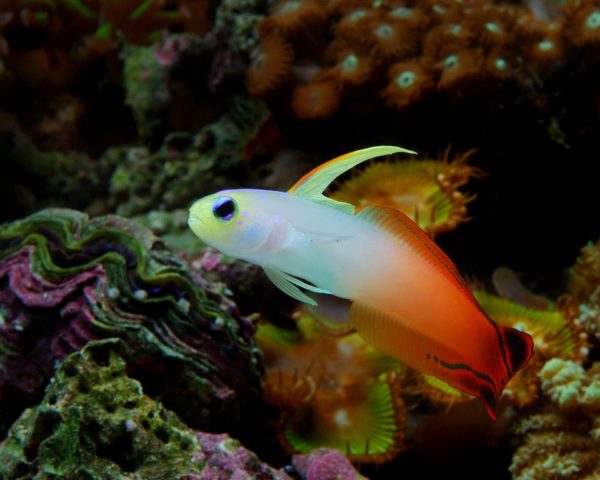
Firefish Tank Size and Specification
These beautiful species are very small in size, and they have a petite structure so that they can be kept in a nano tank; however, we would recommend you keep them in a larger tank due to their darting nature. The tank should have strong water flow current and two square feet of area per couple of fish.
The minimum size of the tank to keep Firefish should be 20 gallons. The larger the tank, the better. These fishes like to jump, so make sure the tank has a strong lid. Ost of the fish owner loses their precious fish due to the simple mistake of not securing the tank properly.
Optimum Tank Size for Firefish
The optimum tank size is 20 gallons.
Tank Shape
The fishes are bottom and middle dwellers, so the shape of the tank should be rectangular as they need extra space to move in the large tank.
Filter Type
These fishes do not need expensive large filters. However, to avoid the growth of bacteria and parasites in water due to water parasites, you can install a filter in the aquarium.
Substrate
The substrate in the aquarium should mirror their natural environment. For example, these fishes are petite and timid and feel insecure quite often, so they need a place to hide from prospective predators.
When you are keeping fish in a tank, mimicking the habitat environment as much as possible means putting live corals, lava and live rocks, and other organisms, also, use aquarium sand to make sure your tiny companion’s fin does not get hurt while hiding in the bottom of the tank.
How Many Fish Can You Keep in A 20-Gallon Tank?
Firefish show aggressive behavior with their kind. They live alone after adulthood until and unless they find their mate. So, if you are buying in pairs, you can put two Firefish in a tank. Otherwise, avoid keeping them together.
Water Parameters for Firefish
Water Temperature
The ideal temperature for Firefish is ideally 72-80 degrees Fahrenheit. So, keep the temperature of the water tank between 70-82 degrees Fahrenheit. In addition, you should keep a water heater as the water in the tank is mostly at room temperature. Especially in cold weather, keeping a water heater is safe for the fish as they won’t succumb to the room’s changing temperature.
Water Flow Rate
The Firefish live in a strong current, and they swim opposite to the current. So, to replicate their natural habitat, you can keep a circulation pump or wavemaker. This pumps the water from the back and pushes it out in the front of the tank. This complements the water flow pattern with the filter and pushes the water from every corner. So, maintaining the flow rate also helps in keeping the tank clean.
pH level
In firefish goby, the pH of the aquarium should be in the range of 8.1-8.4.
Water Hardness
The hardness of the water should be in the tank in between 8-12 dGH. They live in salty water, so the salinity of water should range from 1.020-1.025. You can add sea salt to the tank to create an optimum level of salinity in the tank.
Firefish Tank Landscape
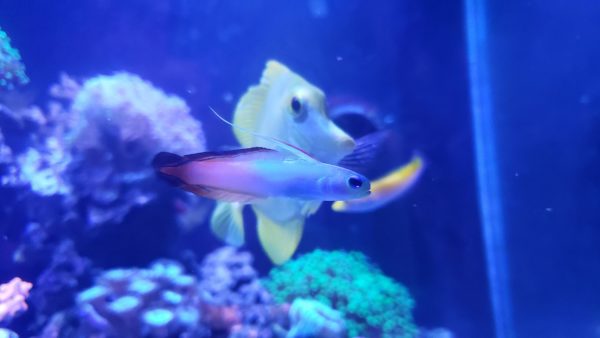
To replicate the habitat of the Firefish in captivity, you will need a medium to large size tank. They need ample space for swimming around. In addition, they show dominance in the tank, so while picking up the size, you must keep in mind, they get ample space in the aquarium. If you plan to keep more than one fish, you should take a tank of 30-gallon size. Firefish enjoy holes and caves, so make sure you put that in the tank.
Best Plants for Firefish
It is recommended to have aquatic life in the tank for Firefish. This helps in improved oxygenation, and it looks marvelous in the fish tank almost like a coral sea.
- Spaghetti Algae is also known as chaeto; it displays bright green color and has fine hair-like strands.
- Halimeda- They are found in the oceans and is a great combination for firefish tank.
- Red Gracilaria Algae- If you are having trouble maintaining the tank’s water chemistry, consider introducing Red Gracilaria. It is effective in maintaining the nutrient content in the tank.
- Red Mangrove Propagule- It performs efficiently in the tank. They help in lowering the nitrates in the tank.
- Zooplankton growing
Worst Plants in The Tank
The tropical aquatic vegetation does not go along with firefish tank Plants such as
Decoration For Firefish Tank
The timid fish gets scared easily, and they want a place for hideouts. So, when you are decorating the tank, make sure you are providing enough space for hideouts. A trim piece of PVC pipe in the shape of a cave serves as great hiding places. To give it a cave-like structure, create a facade of rocks around it.
Solid corals and lava rocks are also welcomed well by the Firefish. You can put driftwood or make a cave with pebbles for them to hide in the bottom of the tank.
Lighting For Firefish Tank
Keep the lighting moderate to low. They get scared in too much bright light. You can even turn off the light sometimes so they can swim around without fear.
Feeding Firefish
Feeding the Firefish will be easy since this fish is an omnivore. With a diet that includes feeding two times a day, you can empower their healthy nutrition. Feel free to offer them meaty foods, along with some vegetarian food and other types of a varied diet.
The Best Diet for Firefish
- zooplankton that grows in the aquarium
- Mysis shrimp
- beautifully chopped frozen foods and fresh seafood
- algae
- brine shrimp
- little crustaceans along with supplemental vitamins
Keep in mind that they are not predatorily in their behavior towards food and will not fight with the other fish when it is feeding time, so you should always watch the Firefish when you feed them, making sure that they are well fed. If not, you can reinforce their food quantity so that they can eat properly.
How Often Should You Feed Firefish?
Firefish should typically be fed twice a day.
Firefish Behavior And Temperament
They are peaceful fish and make a good tank mate for other fishes. They are not aggressive; rather they are an entertainer. However, they get scared easily and are very shy fish in behavior.
Each Firefish requires 10-20 square centimeters of the space as their territory. You may find it astonishing for such a small fish, but they like to be alone in their territory.
Are Firefish Societal or Lone in Nature?
They are societal and make a great company for other tank mates and other species.
Firefish Tank Mates
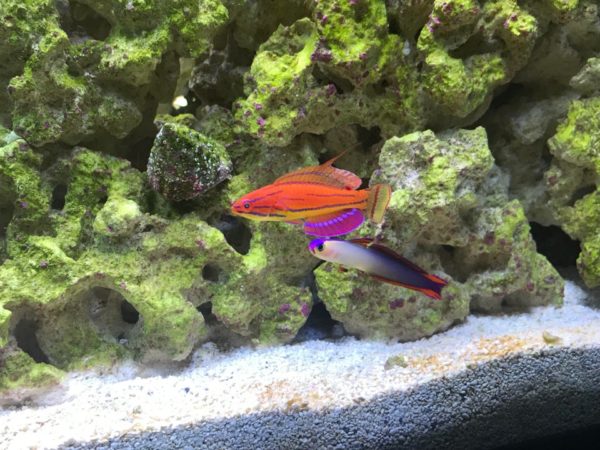
Choosing the right tank mate for Firefish can be easy and difficult depending on their behavior with the fish. They are peaceful, but if they feel threatened, they can become skittish and sometimes aggressive. So, you must pick the one that feels right with the fish.
Another one of the tank conditions for picking the right fish is water temperature and parameters. Pick saltwater fish as they live in saltwater. Tropical fishes do not go along with Firefish.
Ideal Firefish Tankmates
- Cherub Angelfish
- True Percula Clownfish
- Yellow Tang
- Yellowtail Blue Damselfish
Bad Tankmates for Firefish
- Larger Clownfish
- Dotty backs
- Pygmy Angelfish
Breeding Firefish
There is not enough scientific information about how a Firefish breeds, but it is assumed that its practice is much the same as the other Goby fish types.
The Firefish is a monogamous hardy species so that it will have only one partner at a time. However, a pair of Fire fishes will live pleasantly together.
While breeding them, make sure that they are properly nourished, and the water is clean with a functioning filtration system. Remember to keep the lighting dimmed.
Firefish Breeding Level
Moderate
Firefish Sexual Dimorphism
These fishes do not have prominent identifying characters between genders. However, the females are smaller and thinner than males.
Firefish Common Diseases and their Treatment
The common diseases of the Firefish are:
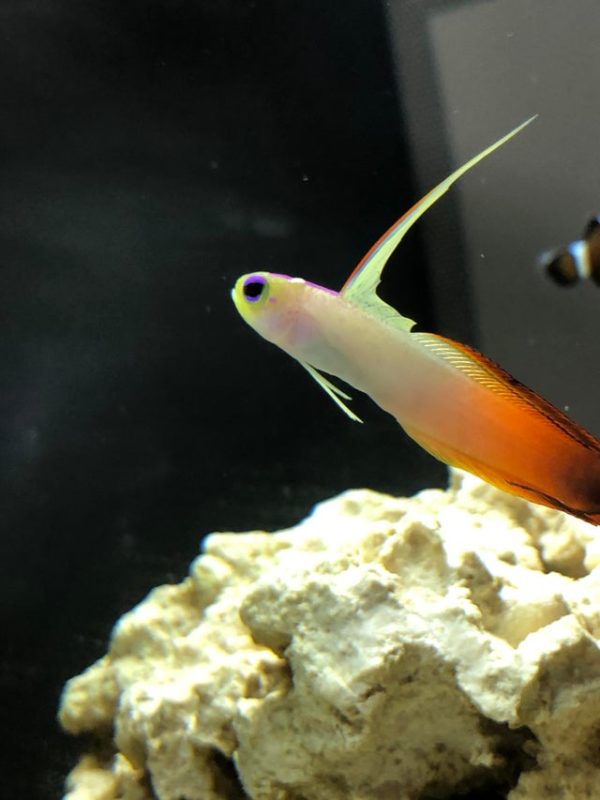
Saltwater ich
The fishes are vulnerable and sensitive to saltwater ich. You can diagnose it by looking at small white dots on the fish. Ich causes a lot of trouble to fish, and you will find them scratching their surface on the rock or driftwood. To cure the infection, but copper sulfate or formaldehyde.
Dropsy
Dropsy is another disease that causes a lot of trouble for the Firefish. This is a bacterial disease and makes the Firefish bloated. After the disease is diagnosed, put them in a quarantine tank and then pass penicillin-based drugs in the water tank.
Facts About Firefish
- They are amazingly intelligent, and they are giving livelihood into the aquarium with their active swimming and positive temperament
- This fish will surely get your attention with its quick movements and dynamic rhythm of life
- Their blended body color is very artistic, half white and half red
- It is very easy to care for them, as they are omnivores, you can feed them with every different kind of fish food, plant, and animal-based
- While swimming, they will get along the front of the aquarium and show curiosity if you are keeping an eye on them, so expect the Firefish to show off what they got so that they may impress their audience. Perfect for kids and guests
Are Firefish Right for You?
Yes, Firefish is right for you certainly, as they need low maintenance and do not fall prey to diseases easily. However, while they need proper care and maintenance, it is still worth keeping a firefish in the tank. The vibrant color and timid structure will be an attraction for your kids. In addition, Firefish is easy to care for and maintain. Moreover, they if do not cause any harm to the owner.
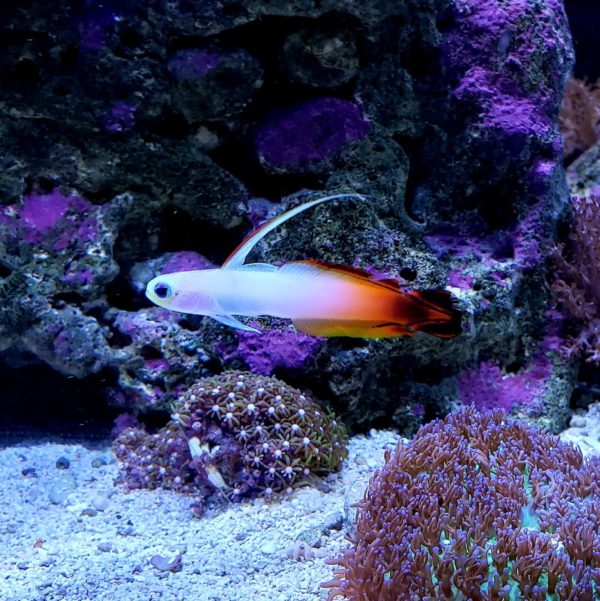
Frequently Asked Questions
How Long Do Firefish Live in Captivity?
They live up to 3 years. However, most fishes live less than 3 years as they have the habit of jumping from the aquarium.
Can I keep Purple Fish in Aquarium?
Yes, they are easy to keep in aquariums. They are peaceful fish and require low maintenance.
Can Firefish Be Kept in Groups?
They are tricky to keep in groups. These species are mostly seen in groups hovering in the reef. However, in captivity, these species can get aggressive with other firefish. So, it is better to keep one Firefish in the tank until and unless they are a couple.
Are Firefish Poisonous?
The goby firefish isn’t poisonous. However, “devil firefish” is poisonous for humans.
Conclusion
In firefish care guide, we have put information on caring for your Firefish in the tank. We know as an aquarist you would like an eye-pleasing fish in the tank, and Firefish is the right one to go for. However, we don’t want you to take home a firefish with a lack of knowledge; that’s why we have gathered all the information in different sections so you can give the best care to the fish.
